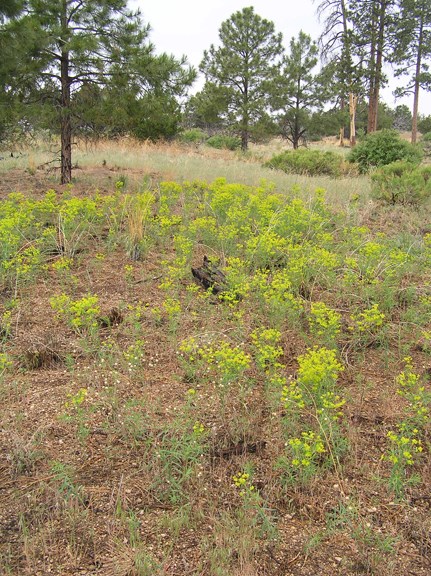
Photo by Brian Jacobs More than 15% of the vascular plant species found within Bandelier were not present in northern New Mexico prior to Euro-American settlement; these exotic, non-native, introduced, or alien species may have origins as far away as Asia or from as close by as an adjacent county or state. Disturbances associated with homesteading, historic overgrazing and loss of fire regime, wildfire, and post- wildfire rehabilitation facilitated the widespread establishment of exotic species at Bandelier, and encouraged the spread of locally native species with weedy habits. The vegetation of semi-arid ecosystems like the monument has been degraded by the impacts of these disturbances primarily through depletion of soil resources which can be very slow to recover. Good land management practices including mechanical restoration and the reintroduction of fire may provide long-term benefits to native plant communities if properly implemented. However, despite best efforts, many introduced species have or will likely become naturalized components of the local flora.
Consistent with the 2006 NPS Management Policy 4.4.4.2 except below, the monument uses a cost-benefit weed management approach to minimize the impacts of alien weeds and contain their spread, while recognizing that complete eradication is in most instances impractical. Primary efforts are focused on those 'targeted' species that can be effectively controlled or contained using mechanical and/ or limited chemical methods.
High priority will be given to managing exotic species that have, or potentially could have, a substantial impact on park resources, and that can reasonably be expected to be successfully controlled. Lower priority will be given to exotic species that have almost no impact on park resources or that probably cannot be successfully controlled. Where an exotic species cannot be successfully eliminated, managers will seek to contain the exotic species to prevent further spread or resource damage.
Of the 15% of plants within Bandelier considered to be exotic, only 2-3% are invasive or noxious with the potential to displace native plants or seriously alter natural systems, and only 1% representing 11 woody or perennial species are both high risk and feasible to treat using current approaches. These general categories of exotic plants are based on a combination of observed threat to park resources, growth form, distribution, habitat, and feasibility to control. As detailed in the 2006 Bandelier Exotic Plant Management Plan, targeted exotics include trees and perennial herbaceous species that have the potential to become more widely established in the absence of any control efforts and are susceptible to containment through mechanical and limited chemical treatments. There are also a number of nuisance level species which are commonly restricted to perennially disturbed areas such as roadsides. Nuisance weeds are managed through best management practices which seek to minimize import of new weeds and transport of existing weeds; these may include basics such as: washing equipment, covering soil piles, keeping vehicles on established footprints, using clean soil / sand, and keeping work areas weed free. These importance practices are effective, especially when implemented consistently. Cheat grass (Bromus tectorum) an annual grass which poses significant ecological risks, is currently infeasible to treat at large scales. Since the mid-1980's we have watched this species expand from scattered patches to a more continuous distribution across the lower elevations of the park; the recent drought mortality during the early 2000's seems to have accelerated its colonization of pumice patches across the woodland zone. Landscape scale herbicidal treatments of a related species post-wildfire had only limited success and being indiscriminate of native vegetation cannot be applied except in cases of weed monoculture following high intensity disturbance. A more promising approach, but one which is likely still years away, would employ biological control agents including insect/ fungal seed predators / pathogens which could significantly impact annual seed crops with minimal collateral damage to our native perennial brome species. We work closely with the National Park Service, Exotic Plant Management Teams (EPMT) to monitor and implement mechanical-chemical treatments of the high priority species listed below. The EPMT teams were modeled after fire-use modules to provide regional weed control capabilities to parks within a regional area given most parks lack requisite staff expertise with chemical treatments. For example, during a 3-year period in the mid-2000's the EPMT treated the monuments' entire six-mile river corridor along the Rio Grande in White Rock Canyon, with pack support provided by a local rafting company. The operation lasted several weeks during each of the three years, utilizing a crew of some 12 sawyers and sprayers to remove thousands of stems of Russian olive, Siberian Elm, and Tamarisk. The existing complement of native riparian vegetation has grown since this treatment, providing reduced opportunities for invasive trees to reestablish along the river corridor. In 2012, the EPMT returned to assist with post-fire weed detection and treatment in areas impacted by 2011 Las Conchas wildfire suppression activities. Trees Ailanthus altissimus (Tree of Heaven) Lost Canyon (formerly in historic orchard) Elaeagnus angustifolia (Russian Olive) Rio Grande Corridor and scattered swales Ulmus pumila (Siberian Elm) Rio Grande Corridor and roadsides Tamarix ramosissima (Salt Cedar) Rio Grande Corridor Herbaceous Perennials Centaurea repens (Russian Knapweed) Rio Grande Corridor Linaria vulgaris (Butter and Eggs) Rio Grande Corridor, and Capulin mesa Lepidium latifolia (Perennial Peppergrass) Rio Grande Corridor Euphobia esula (Leafy Spurge) near Corral Hill Cardaria draba (Hoary Cress) horse corral Melilotus officinalis (Yellow Sweet Clover) roadsides Cirsium arvense (Canadian Thistle) Rio Grande Corridor |
Last updated: April 28, 2025
